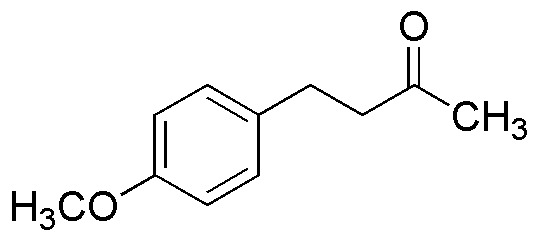4-(4-Methoxyphenyl)-2-butanone is widely utilized in research focused on:
- Flavor and Fragrance Industry: This compound is often used as a flavoring agent in food products and as a fragrance in cosmetics, providing a pleasant aroma and taste that enhances consumer appeal.
- Pharmaceutical Development: It serves as an intermediate in the synthesis of various pharmaceuticals, helping researchers develop new medications with improved efficacy and safety profiles.
- Organic Synthesis: This chemical is a valuable building block in organic chemistry, allowing chemists to create complex molecules efficiently, which is essential for developing new materials and compounds.
- Research in Material Science: It is utilized in the production of polymers and resins, contributing to advancements in materials that require specific properties such as durability and flexibility.
- Biochemical Studies: Researchers use this compound to study its effects on biological systems, aiding in the understanding of metabolic pathways and potential therapeutic targets.
General Information
Properties
Safety and Regulations
Applications
4-(4-Methoxyphenyl)-2-butanone is widely utilized in research focused on:
- Flavor and Fragrance Industry: This compound is often used as a flavoring agent in food products and as a fragrance in cosmetics, providing a pleasant aroma and taste that enhances consumer appeal.
- Pharmaceutical Development: It serves as an intermediate in the synthesis of various pharmaceuticals, helping researchers develop new medications with improved efficacy and safety profiles.
- Organic Synthesis: This chemical is a valuable building block in organic chemistry, allowing chemists to create complex molecules efficiently, which is essential for developing new materials and compounds.
- Research in Material Science: It is utilized in the production of polymers and resins, contributing to advancements in materials that require specific properties such as durability and flexibility.
- Biochemical Studies: Researchers use this compound to study its effects on biological systems, aiding in the understanding of metabolic pathways and potential therapeutic targets.
Documents
Safety Data Sheets (SDS)
The SDS provides comprehensive safety information on handling, storage, and disposal of the product.
Product Specification (PS)
The PS provides a comprehensive breakdown of the product’s properties, including chemical composition, physical state, purity, and storage requirements. It also details acceptable quality ranges and the product's intended applications.
Certificates of Analysis (COA)
Search for Certificates of Analysis (COA) by entering the products Lot Number. Lot and Batch Numbers can be found on a product’s label following the words ‘Lot’ or ‘Batch’.
Numéro de catalogue
Numéro de lot/série
Certificates Of Origin (COO)
This COO confirms the country where the product was manufactured, and also details the materials and components used in it and whether it is derived from natural, synthetic, or other specific sources. This certificate may be required for customs, trade, and regulatory compliance.
Numéro de catalogue
Numéro de lot/série
Safety Data Sheets (SDS)
The SDS provides comprehensive safety information on handling, storage, and disposal of the product.
DownloadProduct Specification (PS)
The PS provides a comprehensive breakdown of the product’s properties, including chemical composition, physical state, purity, and storage requirements. It also details acceptable quality ranges and the product's intended applications.
DownloadCertificates of Analysis (COA)
Search for Certificates of Analysis (COA) by entering the products Lot Number. Lot and Batch Numbers can be found on a product’s label following the words ‘Lot’ or ‘Batch’.
Numéro de catalogue
Numéro de lot/série
Certificates Of Origin (COO)
This COO confirms the country where the product was manufactured, and also details the materials and components used in it and whether it is derived from natural, synthetic, or other specific sources. This certificate may be required for customs, trade, and regulatory compliance.


